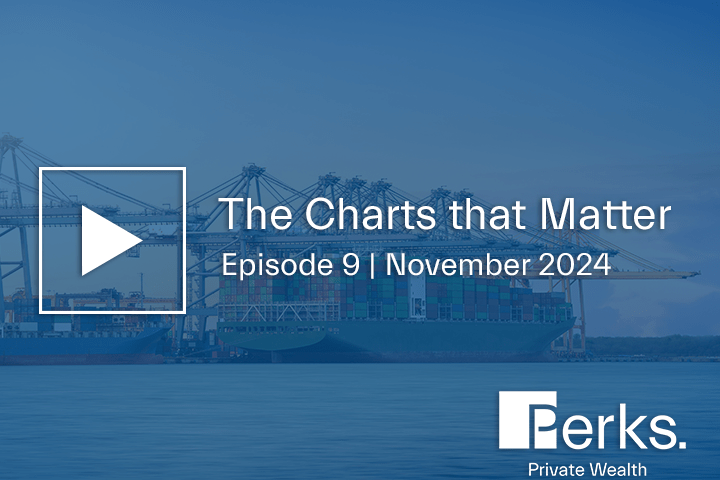Hello, everyone, and welcome back to Charts That Matter. I’m Simon Hill, director of Perks Private Wealth. And joining me today is Christo Hall, chair of our investment committee. As we navigate these complex economic times, we’re here to break down the key insights and strategies. Welcome, Christo.
Thanks, Simon. Good to be here.
Christo, two thousand and twenty four has been an eventful year so far with a unique set of challenges across regions.
Can you give us a rundown of the global economic landscape?
Yeah. Sure, Simon. It’s been, as you said, a very interesting year, and there’s been quite a divergence between countries. So if you look at the US, the US economy’s been, you know, pretty resilient, actually, and, has held up pretty well. We’re starting to see, some, some adjustments now, some slowdowns now, and that’s why we’ve seen the Federal Reserve begin its rate cutting cycle.
But still, you know, economic growth is holding up pretty well. If I go to Europe, Europe had a very, very tough two thousand and twenty three, but is now showing signs of gaining some traction. But again, it’s very moderate, so we’re not seeing any real, you know, strength in in economic growth. It’s just at a moderate level.
If we focus more on Australia back here, we’re really lagging the other economies. Australia is, actually really a little bit more difficult, because inflation has been more persistent here, and therefore, we have yet to start our rate cutting cycle. And that’s really beginning to hurt the consumer.
And you can see that just from what’s happening to the consumption levels versus other countries, and we’re probably in a what we call a, a consumer GDP recession, which I think is is shown in the data.
So, we’ve got some challenges in Australia as we head into twenty twenty five.
With these varied conditions, how are inflation trends shaping up across these regions? So, again, we’ve got real divergence that’s occurring across, a number of jurisdictions.
If I look at the US, I mean, inflation has been coming down quite quickly and is getting close to the, to the Fed target, on a headline inflation basis.
And so, you know, that’s why we start to see the Federal Reserve cut rates, as I mentioned, fifty basis points, cuts in September.
If I look across to Europe, that is within the, European Central Bank targets. Their inflation targets have been met, which is why we’re starting to see economic growth, start to recover more robustly in that area than in other jurisdictions.
Australia has been more challenging. We’re yet to start, cutting rates here, and inflation has come down, but it’s remaining still stubbornly but high. And the reason for that has been based around government policy, and the spending we’ve seen in the budget both at the state and federal level. That’s what’s been, a point of difference between us and in other countries that’s really hampering, the ability to get our inflation down to the Reserve Bank target levels.
So that’s been challenging. And, the outlier is Japan, where we’ve actually started to see rate rises. So, you know, again, that their inflation, they’re always well and truly under control. In fact, they need a bit more inflation, to come back into the economy.
So it’s very much a case of moving parts for different parts of the world, but we’re going to see, you know, timing differences here between when we start seeing inflation really begin to base out and what that means for interest rate policy.
So you talked about Australia before. What does that mean for interest rates in Australia when we look forward over the next twelve months?
Yeah. So there’s been an I think something like, fifty percent of, of developed countries have started cutting rates already.
I mentioned the US, but there’s also, the, you know, the UK and there’s a number of countries in Europe, Canada.
We’re to do that. We haven’t shifted yet, for the reasons I outlined, a minute ago. I don’t see Australia begin to start cutting rates until around about March of next year.
And the key is the magnitude of the rate cuts. So if I look at the US, they’ve done a fifty basis point cut in September. I see another hundred basis points of cuts coming throughout twenty twenty five for the US. So around about a hundred twenty five basis points or one point two five percent in total.
But bearing in mind, they had higher rates than Australia did when they began cutting.
When I look at Australia, I see a much more moderate rate cutting cycle.
So I expect Australia to end up cutting between seventy five and a hundred base points or between three quarters of one percent through this cycle.
So it’s not going to be as aggressive as what we’ve seen in the US. And the reason for that is we have elements in our economy, particularly around, wages with the unions and around rents, which are gonna make it much harder to get inflation down to that that target rate that the Reserve Bank’s gonna feel comfortable with.
Japan seems to be the outlier against the rest of the world. And I think about how many Australians travel to Japan each year.
What does it mean for them?
So Japan’s just a really interesting case at the moment because over the long term, normally, we’ve had, you know, strong Aussie dollar and US dollar relations with the with the yen. And the reason for that is because, until, you know, really the last twelve months or so, we’ve had very, very low interest rates in in Japan, for years.
That dynamic’s been changing, and I mentioned the inflation story earlier on. So the Bank of Japan started raising rates, to try and make sure that inflation doesn’t run too far ahead of itself.
While that’s important, why that’s really important is, in financial markets, there is, there is a, an activity called carry trade. And essentially what that is is for years, people in the US, people in Australia have been borrowing money in Japan because it’s such a low interest rate relative to rates in their own countries, and then reinvesting that money in their own countries. So it’s been quite a spread differential between interest rates in Japan versus the US and Australia, and that’s what they’ve been capitalizing on.
What’s happening now, of course, Simon, is with rates going up in Japan and the US and Australia either cutting or about to cut rates in this cycle, you’re seeing that dynamic shift. And why that’s important is we’ve had billions of dollars that have flowed just in a one way movement for years now, and that starts that’s starting to reverse because it’s more attractive now to put money back in Japan because they’re raising rates. And that has a big influence or can have a big influence on markets, and we saw some signs of that a couple of months ago. So we need to be, that’s what we need to watch, just from a, just from a, you know, from a market’s perspective.
From a, from a travel perspective, very interesting. I mean, Japan has been a great destination for Australians.
And even for those of South Australia, I think we’re beginning direct flights to Japan in twenty twenty five.
And, really, we’ve been very fortunate where the currencies have been to be able to get to Japan, pretty cheaply. In fact, I’ve seen in a publication I read a couple of weeks ago, Japan is pretty much relatively the cheapest destination for Australians to travel from a currency perspective.
But with this dynamic that I’ve outlined, that window is probably going to close. So we’re likely to see that, move the other way. So it’s going to become a bit more expensive to for those that are willing to travel to Japan. I’d imagine in the next twelve months, you’d wanna do it sooner rather than later because it will be more expensive to travel there once those county adjustments occur.
Christo, just on currency, what about the Australian dollar to the US?
So, I if you look at the what we call the purchasing power parity, between the two countries, fair value for the Australian dollars around about seventy two cents.
It’s been a little bit weaker in the last month. That’s been due to commodity prices being softer, and that’s all been due to China having very sluggish economic growth.
But, we’re currently around about, you know, sixty six cents at the time of this recording. So, we see the currency begin to, you know, appreciate against the US, particularly driven by the rate of and the magnitude of rate cuts in the US versus that of Australia.
If we just focus on the US, there’s a lot happening over there. And as we record today, we’re only two weeks out from the election.
How’s all that gonna play out in terms of economies and markets?
So right now, the polls are showing that Trump’s slightly ahead, but it’s a very, very close, you know, election result, that we’re looking at here.
Interestingly, there are different policies from each party, but, they are both going to be inflationary.
I’ll just elaborate on that. So what would a Trump victory, mean? The Trump victory will see, likely tax cuts, to continue in the US, which will be good for the consumer.
But he’s also made it pretty clear that he’s gonna be very aggressive towards China with regard to, tariffs being placed on that country in order to protect industries within the US. That will be very inflationary if that occurs. So you’ve got an inflation tailwind from Trump policies. If I look at the Democrats and Kamala Harris, you know, a big part of their, of their policy, narrative is spending on social services and lifting the minimum wage significantly.
So, again, they won’t be so aggressive, you know, geopolitically towards other countries from an economic standpoint.
But domestically, they’re gonna be spending a lot more on supporting, providing support for those less fortunate. But again, that will be inflationary as well. So, both camps, or both parties, whatever the outcome, I see this inflationary issue that will need to be handled really carefully by the Federal Reserve in the way that they manage their interest rate policy going forward because they’re both gonna have a bit of tailwind behind that, those those inflation rates.
And, Christo, what about geopolitical tensions around the world at the moment?
So, I mean, the big one at the moment is obviously what’s happening in the Middle East.
And what that is doing is, as that spreads to become more of a regional conflict, it’s starting to have an impact on the oil price. So you’ve got, you know, moderate economic growth and softening economic growth, which has been pushing oil prices down. But now with this, geopolitical tension, you’re starting to see, obviously, some concerns around the supply of oil if some of these big oil producing countries such as Iran get more proactive in the war, which is forcing the oil price up. So we need to watch that very carefully because, a, it’s inflationary if oil prices go higher, and and, b, that will flow through to, you know, the risk that’s priced into markets. And what I mean by that is it’s probably not really pricing in, an outcome where we get a much more extended and expanded, you know, war in the Middle East.
So we’ve discussed economies and geopolitical tensions and the challenges attached to that.
What does all that mean for investment markets?
So, I mean, the markets have had an incredibly strong year as we know overall, and it took particularly, obviously, equity markets.
And to be frank, stronger than I thought that they would be.
And all of that’s been to do with the central bank’s ability to be able to manage, you know, keeping growth, you know, slowing down but not falling off a cliff.
And so therefore, keeping, you know, company profits still growing, but at a moderate rate. And so, the markets, felt very comfortable with that. That’s what we call a Goldilocks, scenario. So the the central banks have managed that all pretty well.
I mean, in the US, of course, a lot of the the, the increase, has been from the performance of tech. It’s been a very, very strong market, but it is starting to broaden out now. The recovery is starting to see that broaden out into more traditional, sectors of the market.
So we’re looking at a more subdued economic growth outlook, if you look at the market as whole, but we’re now at a situation where they’re cutting rights in the US, and that’s good for valuations.
So, the US market still looks alright. It’s expensive, but it’s not overly expensive. And I can say that for, for a number of markets around the world excluding, Asia and China, and I’ll come to that in a minute. But markets are looking, you know, pretty full, but, some more expensive than others. But the backdrop still looks, at this stage, you know, quite constructive for markets going to next year. There’s not gonna be, from what I can see, any sort of major, major shocks unless they’re, unless they’re geopolitical.
Christo, what about Australia?
Yes. So Australia is interesting. I mean, the market’s been, again, strong throughout twenty twenty four. Not as strong as the US, but it’s been we’ve seen some really healthy gains.
And a lot of that was driven by the performance of the banking sector, who really benefited from rising rates. But, that looks as though that’s played out in full now, given we’re going to go into a rate reduction environment and the economy is softening. So you’d expect that we’re going to start to see a lift in bad debt. So given where banks are priced at the moment, I’d expect that wouldn’t we get much more upside in banks from where we are now.
Resources have been quite weak, particularly recently on the back of, a very sluggish Chinese economy.
Now the Chinese have started stimulating again recently. They announced a program, a few weeks ago.
And that will flow through and that will help. But the question mark is, is it gonna be enough to be able to lift the economic growth rate with that economy?
That’s the million dollar question. It’s gonna be quite hard because the property sector in China is in very, very bad shape, and that’s having significant, impact on, you know, default rates in the banking sector because of the exposure to, you know, the real estate market in in China.
So overall, the Australian market still looks okay. It looks expensive, but we’re not looking at expecting any, massive earning shocks.
On the downside, if China simulates more aggressively than thought, that will really help the resource sector, which will really start to help the Australian market more, if we see that sort of event. But it looks, it looks alright, as we go into twenty twenty five.
So, Christo, if we’re pulling all this together from a portfolio construction perspective, where should clients be looking to place money?
So if you look at the way that we’ve had the clients positioned, particularly with regard to our strategic asset allocation, I mean, obviously, equities has been a really, really good year.
But as I’ve mentioned, you know, earlier in the video, some of those valuations look okay, but some of them look a bit extended, some of those jurisdictions of those countries. So you need to be mindful of carrying too much, equity exposure over, you know, the the the strategic asset allocation weight.
We’ve been very, very positive on bonds throughout twenty twenty four, and that’s been the right call. But in the last quarter, they’ve had some really, really strong returns, as far as the government bonds goes.
And I see that the majority of those good returns are probably being made already, given where we are in the cycle, because obviously, bond markets like share markets preempt what’s going to happen to a certain degree in the future. So a lot of the scenario, the economic scenarios we’re expecting are getting priced into that.
We do see pockets of value in in private credit.
It’s a very strong, growing asset class, and you’re getting, you know, some really interesting exposure, to different, segments of the economy through through credit.
And we do see some, as I said, some pockets which we’re which we’re looking at very, very carefully. I think that will present some, further opportunities in twenty twenty five for, for clients. I mean, if we look at the property market, that’s been really interesting. It’s, the different asset classes within property have been behaving differently. So industrial properties continue to remain really strong, but that’s probably starting to reach the best of its returns. It’s been a very, very strong market.
The the retail market, particularly the shopping center market, saw some very, very material write downs in valuations as we went through went through twenty twenty four. Those valuations are probably starting to bottom out now, and in fact, we’re seeing some selective buying of retail shopping centers. There’s some really good businesses there that are trading at big discounts to their, NTA.
And Office is supposed to probably still have some more pain to go. We’re still going through those valuation, write downs. We’re not there yet on in the Office market.
I expect that to probably trough around about June of next year.
But they’ve got some structural issues involved there. So the different markets are all behaving, a little bit differently. But, you know, as we’ve said in the past, it’s all about being diversified with your portfolio construction, to make sure, you know, your risk diversification is appropriate for your own, investment objectives and, you know, we continue to recommend that that stance.
So on infrastructure, I see some interesting opportunities here. It’s been a great inflation hedge over the last few years particularly, and unlisted infrastructure has performed very, very strongly.
We had seen some weakness in listed infrastructure, stock performance, but that’s now starting to catch up to that unlisted, the unlisted valuation. So I think there is gonna be some more opportunity, in that space. And the critical point to know is that the spending on infrastructure from governments and the like, it’s gonna create a lot of opportunities in that marketplace, to participate in, in co investment. So looking forward to seeing how that goes throughout twenty twenty five.
Thank you, Christo, for sharing all your thoughts, and thank you to everybody for tuning in. We’ll continue to keep you updated with the latest market insights in our next edition.
Thanks, Simon.








